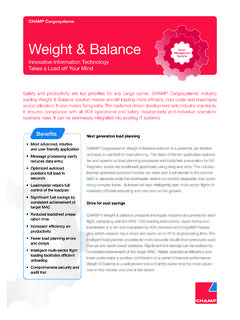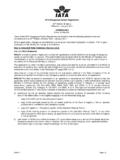Transcription of Visual Fields AOA - Optometry's Meeting
1 5/19/20141 Understanding Visual FieldsSteven Ferrucci, OD, FAAOC hief, Optometry; Sepulveda VA Professor; SCCO/MBKU WHAT The Visual Fields are a measure of the area you are able to perceive Visual signals, when your eyes are in a stationary position and looking straight ahead WHY Measures the Visual integrity between the retina and the Visual cortex HELPS US Understanding of functional abilities. Help diagnose a vision/brain condition. Monitor treatment/progression of condition. USES:Glaucoma Glaucoma affects peripheral vision before central vision Assists in Diagnosis and Following of glaucoma Neurologic Strokes cause characteristic Visual field loss Diagnose and help localize lesions Other RP.
2 Blepharoplasty Historical perspective Hippocrates described hemianopsia in late 5thcentury BC Measurement of VF extent by Thomas Young in early 1800 s VonGrafe provided first quantitative assessment in 1856 Hans Goldmann and his perimeter in the 1940 s Quick review Normal adult dimensions Threshold measurement is the intensity of stimulus that can be detected by the patient 50% of the time. Db- the dimmer the stimulus the higher the threshold number (Db), patient is more sensitive. By testing multiple locations at the threshold an isopter is formed50-60 deg superiorly 70-75 deg inferiorly 60 deg nasally 90-100 deg temporally Types of VF Defects: Scotoma: A defect surrounded by normal Visual field Relative; an area where dim objects cannot be seen but larger or brighter ones can Absolute: nothing at all can be seen in that are Generalized depression: Overall VF is reduced vs.
3 What it is expected5/19/20142 Types of VF Defects: Hemianopia: binocular field defect in each eye Bitemporal: the two halves lost on the outside, or the temporal side Homonymous hemianopia: the two halves are on the same side of the Visual field , to the right or left Getting set up: Consider your patient Choose the appropriate test Screener vs threshold test Peripheral vs central Ensure good testing /reliability Correct Rx Patient limitations Analyze data Make appropriate treatment recommendation OPTIONS: Confrontation Fields Manual perimetry Goldmann, Tangent Screen Automated VF Humphrey, FDT, Octopus, others Confrontation Fields Quick and easy screener Doesn t require equipment Catches large defects Advantages of Manual Perimetry Greater interaction between examiner and patient Not confined to VF testing algorithms Adaptable to patient Ex.
4 Goldman, Tangent Screen Advantages of Automated Perimetry More sensitive/reproducible Quantitative information Results in a more timely manner Experienced perimetrist is not required With newer perimetric tests, early detection of glaucomatous damage is possible EX: Humphrey, Octopus5/19/20143 Tangent Screen Simple and more sensitive than confrontation Fields Black felt screen with stitched circles 5 degrees apart Tests to 30 degrees at 1 meter ( feet) Different color targets Smaller target makes for a more sensitive test Distance correction, including + for presbyopes at 1 m No multifocals Plot from non seeing to seeing, BS first Monitor patients fixation Goldman manual perimeter- Easier to test large defects hemianopsias, low vision patients (ex: RP) or patients who cannot sit through a Humphrey field .
5 Calibrated bowl instrument background set at apostilbs (in photopic range) Can change size and intensity of target to plot different isopters Roman numeral = size of stimulus Number and letter = intensity of stimulus Plot the blind spot Test each meridian from non seeing to seeing Vertical and horizontal meridian Place a dot at each meridian as soon as the patient clicks the button Monitor fixation througout Form isopter Evaluate5/19/20144 Humphrey Automated Light stimulus is flashed a number of static locations, if not seen intensity is increased. Calculates field according to age matched norms (STATPAC) Option of kinetic perimetry, social security disability or custom as well FDT Tests supra threshold in 45 seconds and threshold in about 4-6 minutes.
6 Normal room lighting Automatically occludes eye 17 regions tested within central 20 degrees High sensitivity and specificity for identifying glaucomatous defects. Excellent for SCREENING Octopus Standard automated, SWAP, flicker, goldmannautomated or manual kinetic Automated eye tracking Faster threshold testing (2:30): TOP test strategy Tells you when lens is too far: eliminates rim artifact Also has progression analysis software5/19/20145 Before starting! Make sure date of birth entered Results are compared to normative data base Make sure correct RX is used Calculate trail lens Use set procedure Explain test to patient Get patient positioned in instrument Cover eye NOT being tested Choose your test Ex: 24-2, 30-2, 10-2 , 60-4 SITA Standard/Fast: collects twice as much info, faster , starts testing near threshold.
7 Time interval customized to patients responses. SITA SWAP: faster blue yellow threshold test for early detection of glaucoma Full ThresholdVisual field interpretation Visual Fields are inherently variable Consider learning effect/fatigue on psychophysical testing Makes our job more difficult We must look for overall trends to identify progression New statistical analyses intend to help with this5/19/20146 Reliable? Does the VF defect respect the horizontal or vertical meridian? Is the VF defect in one or both eyes? Is the VF defect in the papillomacular, arcuate or nasal nerve fiber bundle?
8 If binocular, is the VF defect on the same side or the opposite side? If on the same side, are the VF defects carbon copies? Crunching numbers Reliability indices Fixation loss- should be less than 20 %, watch patient through test, make note of good fixation on print out False positive- trigger happy Patient pressed the button when no light was presented. False negative- patient could not see a bright stimulus in a place they previously saw a dim stimulus Studies: Both should be less than 33% to be reliable Actually, less than 10-15% Sources of Error Poor performance Uncorrected Rx Lens rim defect Media opacity Ptosis/dermatochalasis Inadequate retinal adaptation Visual field should match clinical findings Color vision Visual Acuity Optic Disc Appearance Grey scale Graphical representation of the raw data Total deviation Raw data and graphical representation of how the patient did compared to age matched normals.
9 Zero = exact match, (+)patient did better than his peers (-) patient did worse than his peers. Pattern deviation Graphical and numerical representation of field without generalized depression Accentuates focal areas of damage. A high number may indicate loss in discrete areas5/19/20147 Glaucoma hemifield test (GHT) Compares points in the upper hemifield to corresponding points on the lower hemifield with the assumption that sensitivity should be similar in both Fields . Visual field index (VFI) Global index gives you percentage of useful vision remaining Central parts of the Visual field are weighted more Trend based analysis.
10 Pts age plus velocity of progression Enhanced Guided Progression Analysis (GPA) Flags statistically significant progression automatically and tracks current rate of progression through a combination of threshold and SITA strategies Prints a one page summary of progression Projects current rate of projection up to 5 years Media opacities corneal scars, cataracts, vitreous hemorrhage Retina/ONH level RD, AMD, glaucoma Brain Early Visual pathway: Optic nerve, chiasm, optic tracts Late in the Visual pathway: LGN, Optic radiations, Visual cortex VF Defects in Glaucoma: Arcuate defects , bjerrum scotoma Nasal Step Paracentral scotoma Temporal wedge Blind spot enlargement5/19/20148 Look for patterns!









